Class 12th Biology - Sexual Reproduction in Flowering Plants Case Study Questions and Answers 2022 - 2023
By QB365
QB365 provides a detailed and simple solution for every Possible Case Study Questions in Class 12 Biology Subject - Sexual Reproduction in Flowering Plants, CBSE. It will help Students to get more practice questions, Students can Practice these question papers in addition to score best marks.
QB365 - Question Bank Software
Sexual Reproduction in Flowering Plants Case Study Questions With Answer Key
12th Standard CBSE
-
Reg.No. :
Biology
-
The pollen grains may be shed at the two-celled stage (as in 60 per cent of angiosperms) or in the three-celled stage (as in the remaining species). When once shed, the pollen grains must land on the correct type of stigma before they lose viability, to effect fertilisation.
(a) The period for which the pollen grains remain viable is highly variable depending on the species. Substantiate the statement with two examples.
(b) Mention two environmental factors, which affect the pollen viability.(a) -
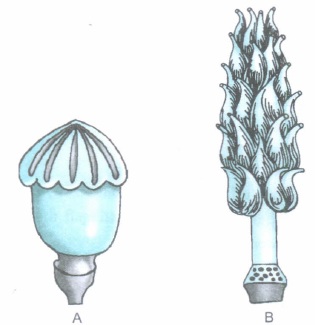
These pictures show the gynoecium of A. Papaver and B. Michelia.
(a) Write one similarity and one difference between the two.
(b) Name the three parts of a pistil.(a) -
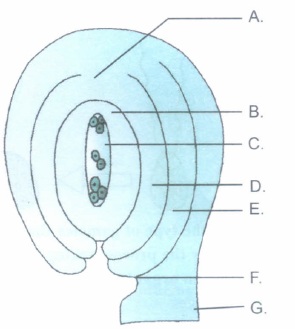
The diagram of an anatropous ovule is presented above.
(a) Give the technical term for ovule.
(b) Identify and name the part that
(i) attaches the ovule to the placenta
(ii) remains as perisperm in some seeds.
(iii) forms the testa of seed.
(iv) represents the basal part of the ovule.
(v) represents the female gametophyte.(a) -
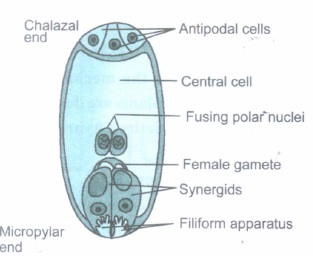
A fully developed embryo sac
A fully-developed and mature embryo sac is shown above.
(a) Name the cell from which it has developed.
(b) What is the ploidy level of its nuclei?
(c) What is filiform apparatus? Mention its significance.(a) -
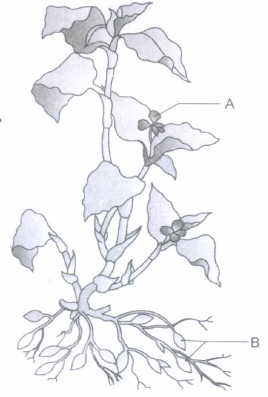
Identify the types of flowers A and B on the Commelina plant shown above.
(b) Mention the type(s) of pollination that can occur in each of them.(a) -
A flower of a tomato plant produced 200 viable seeds after sexual reproduction. Answer the following questions giving reason for each.
(a) How many ovules must have been there in the ovary?
(b) How many megaspore mother cells were involved?
(c) How many male gametes have been required in the production of 200 viable seeds?(a) -

(a) Identify the parts A and B.
(b) Name (i) the initial cell from which it has developed and (ii) stage of embryo prior to this.
(c) Draw a labelled diagram ofthe stage of embryo succeding this.(a) -
Hybrid varieties of several of our food crops are being extensively cultivated. Cultivation of hybrids has increased the crop production tremendously. But, the problem of hybrids is that the hybrid seeds have to be produced every year.
(a) Name and explain the mechanism by which seeds from hybrid plants are developed that are able to retain the desired hybrid characters in the progeny.
(b) What is polyembryony?(a) -
Read the following and answer any four questions from (i) to (v) given below:
The pollen grains or microspores are the male reproductive bodies of a flower and are contained in the pollen sac or microsporangia. Each pollen grain consists of a single microscopic cell, possessing two coats : the exine and the intine. The exine of a pollen grain is made of chemically stable material. Because of this, pollen grains are often very well preserved for thousands of years in soil and sediments.
(i) One of the most resistant biological material present in the exine of pollen grain is(a) pectocellulose (b) sporopollenin (c) suberin (d) cellulose (ii) The exine possesses one or more thin places known as
(a) raphe (b) germ pores (c) hilum (d) endothecium (iii) What is the function of germ pore?
(a) Emergence of radicle (b) Absorption of water for seed germination (c) Initiation of pollen tube (d) All of these. (iv) What is the key advantage to the plant for having such strong pollen grain walls?
(a) It protects the vital genetic material in the pollen grain
(b) It allows pollen to serve as a valuable fossil record for the study of ancient plants.
(c) It prevents the pollen tube from growing out before the pollen grain reaches the stigma of a compatible species.
(d) It gives weight to the pollen grain, allowing it to cling better to the body surfaces of insect pollinators..
(v) The number of germ pores in dicots and mono cots respectively are(a) one and three (b) three and two (c) two and three (d) three and one (a) -
Read the following and answer any four questions from (i) to (v) given below:
Cross pollination is the transfer-of pollen grains from the anther of a one flower to the stigma of a genetically different flower. It is performed with the help of an external agency which may be abiotic (e.g., wind, water) or biotic (e.g., insects, birds, bats, snails). The diagram shows the carpel of an insect pollinated flower.
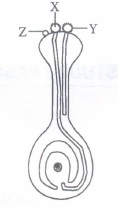
(i) What is the most likely reason for non germination of pollen grain Z?
(a) Pollen grains X and Y were brought to the stigma earlier, therefore, their germination inhibited the germination of pollen grain Z.
(b) Pollen grain Z was brought to the flower by wind, while pollen grains X and Y were broughtto the flower by insect
(c) Pollen grain Z lacks protrusions that allow it to adhere properly onto the stigma surface
(d) Pollen grain Z comes from a flower of an incompatible species
(ii) Which of the following best describes the function of the pollen tube?
(a) It acts as a conduit to transport male gametes from the anther to the ovule
(b) It acts as a conduit to transport male gametes from the stigma to the ovule.
(c) It contains key nutrients that serve to nourish the newly-formed zygote
(d) It digests the tissues of the stigma, style and ovary.
(iii) Pollination of a flower in which the pollen is carried by an insect is called(a) anemophily (b) ornithophily (c) entomophily (d) malacophily. (iv) Refer to the given characteristics of some flowers:
A. The stamens hang out of the flower, exposing the anthers to the wind. B. The pollen grains are tiny and light C. The flower has a sweet scent. D. The flower petals are brightly coloured. How many of the above characteristics are of insect-pollinated flower?
(a) One (b) Two (c) Three (d) Four (v) Pollenkitt is generally found in
(a) anemophilous flowers (b) entomophilous flowers (c) ornithophilous flowers (d) malacophilous flowers. (a) -
Read the following and answer any four questions from (i) to (v) given below:
Many adaptations are found in flowers to achieve certain kind of pollination. The pollination achieved by insects is known as entomophily. The given diagram shows the cross-section of an anther of an insect pollinated flower.

(i) Which of the following is/are the function(s) of structure Y?
A. To carry waste products away from the anther.
B. To supply oxygen to the cells of the anther.
C. To transport food and mineral salts to the anther.
D. To supply water to the anther.(a) C only (b) C and D only (c) A, Band D only (d) A,B,C and D (ii) Which of the following most accurately describes the structures found in compartment X?
(a) They contain two haploid nuclei resulting from meiosis
(b) They contain two haploid nuclei resulting from mitosis
(c) They contain two haploid male gametes resulting from mitosis
(d) They contain a vegetative nucleus and pollen tube nucleus(iii) Which of the following is a distinctive characteristic of insect-pollinated flower?
(a) All of them have nectar guides on their flowers
(b) They produce sugary fruit
(c) Their pollen grains tend to have rough surfaces
(d) They produce abundant quantities of pollen to
make up for pollen grains that might be removed by the wind(iv) Which of the following are likely characteristics of the structures found in X and stamens of this plant?
Structure of X Stamens (a) Abundant and light Pendulous (b) Rough surfaces Non-pendulous (c) Light and sticky Pendulous (d) Coarse and sticky Protrude outside the flower (v) Spiny or sticky pollen grains and large, attractively coloured flowers are associated with
(a) hydrophily (b) entomophily (c) ornithophily (d) anemophily (a) -
Read the following and answer any four questions from (i) to (v) given below:
In angiosperms, the pollen grains are being transferred from the anther to the stigma and is termed pollination. This phenomenon was first discovered by Camerarius (1694) in the end of seventeenth century. Pollen grains are immobile. They cannot reach the stigma by themselves. An external agent is required for this. The pollination is mainly of two types-self pollination and cross pollination.
The diagram given below shows two plants of the same species showing different types of pollination.
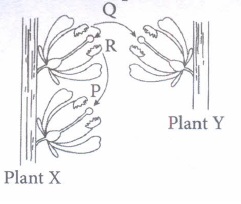
(i) What is transferred between the plants in the process indicated by arrow P?(a) Ova (b) Pollen (c) Nutrients (d) Seeds (ii) Which of the following statements is correct regarding processes P,Q and R?
(a) Processes P, Q and R introduce genetic variability in the offspring of sexually reproducing plants X andY.
(b) Wind serves as agent for process Q if plants X and Y belong to Genus Salvia.
(c) Flowers of plants X and Y need to produce odour and nectar for completion of processes P and Q if they-are entomophilous.
(d) If plants X and Y belong to Genus Cannabis, then their flowers need to produce sticky and heavy pollens in very small amount for accomplishment of process Q.(iii) Identify the processes P,Q and R.
P Q R (a) Geitonogamy Xenogamy Autogamy (b) Allogamy Chasmogamy Cleistogamy (c) Autogamy Geitonogamy Xenogamy (d) Geitonogamy Allogamy Autogamy (iv) In Catharanthus, the growth of style brings the stigma in contact of ripe anthers present on the mouth of corolla tube. This is an example of
(a) homogamy (b) cleistogamy (c) geitonogamy (d) xenogamy. (v) Which of the given processes represents a type of pollination that would result in greater adaptability of the particular species to potential environmental changes?
(a) P (b) Q (c) R (d) All of these (a) -
Read the following and answer any four questions from (i) to (v) given below:
Pollen-pistil interaction is the group of events that occur from the time of pollen deposition over the stigma to the time of pollen tube entry into ovule. It is a dynamic process which has checks at several places for promotion or inhibition of pollen growth. Pollen-pistil interaction is a safety measure to ensure that illegitimate crossings do not occur. Compatibility and incompatibility of the pollen-pistil is determined by special proteins. The compatible pollens are able to absorb water and nutrients from the surface of the stigma. They germinate and produce pollen tubes. Pollen tubes grow into the style. Their growth and path through the style are also determined by specific chemicals.
(i) Which of the following parts of gynoecium determines the compatible nature of pollen?(a) Stigma (b) Style (c) Ovary (d) Thalamus (ii) In Trifolium, which type of self-incompatibility is found?
(a) Gametophytic self-incompatibility (GSI) (b) Sporophytic self-incompatibility (SSI) (c) Both GSI and SSI (d) None of these (iii) Select the incorrect statement.·
(a) In Asteraceae, incompatibility is due to the genotype of the sporophytic stigmatic tissues
(b) In members of Brassicaceae, incompatibility is due to the genotype of the pollen
(c) Nature has imposed self-incompatibility to avoid highly homozygous individuals which have a very low survival value
(d) None of these(iv) Which of the following are examples of self incompatibility?
(a) Tobacco (b) Potato (c) Crucifers (d) All of these (v) Given figures show the pollen-stigma interaction, where pollen wall proteins are released onto the pellicle of stigmatic papillae, where recognition reaction occurs.
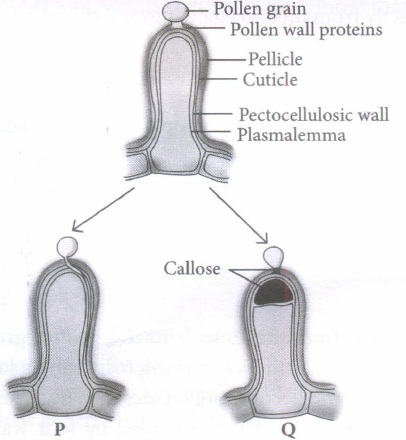
Which of the following statements drawn from given figures is incorrect?
(a) P indicates compatible reaction in which the pollen tube penetrates the cuticle and grows down the papilla.
(b) Development of callose plug between the plasma membrane and pectocellulosic layer of stigmatic papillae results in the incompatibility reaction in Q.
(c) A callose plug which appears at the tip of pollen in Q, is dissolved by callase enzyme secreted by stigma resulting in compatibility reaction.
(d) Deposition of callose can be employed as a reliable bioassay to detect compatibility or incompatibility reactions of pollen and stigma(a) -
Read the following and answer any four questions from (i) to (v) given below:
Apomixis is a mode of reproduction which does not involve formation of zygote through gametic fusion. In plants, apomixis commonly mimics sexual reproduction but produces seeds without fertilisation. There are several methods of apomictic development in seeds. The two common ones are recurrent agamospermy and adventive embryony.
(i) Apomixis is a type of reproduction in plants in which
(a) fertilisation does not take place
(b) male nucleus takes part in fertilisation
(c) pollen fusion takes place
(d) generative nucleus takes part in fertilisation(ii) Which of the following statements is incorrect regarding recurrent agamospermy?
(a) It is the formation of seed that has an embryo formed without meiosis and syngamy
(b) All the cells of embryo sac are diploid.
(c) An embryo develops directly from a diploid cell other than egg like that of nucleus and integument
(d) None of these
(iii) Adventive embryony is found in(a) Citrus (b) Opuntia (c) Apple (d) Both (a) and (b). (iv) Formation of embryo directly from diploid egg without fertilisation is called
(a) apospory (b) diplospory (c) polyembryony (d) diploid parthenogenesis (v) If any somatic cell of sporophyte produces gametophyte without reduction division, it is called
(a) parthenogenesis (b) apogamy (c) apospory (d) amphimixis (a) -
Read the following and answer any four questions from (i) to (v) given below:
The anther is a four-sided structure consisting of four microsporangia located at the corners two in each lobe. The microsporangia develop further and become pollen sacs. In a transverse section, a typical microsporangium appears near circular in outline. It is generally surrounded by four wall layers-the epidermis, endothecium, middle layers and the tapetum.
(i) A dithecous anther consists of (A) microsporangia, (B) in each lobe. Select the option that correctly fills the blanksA B (a) four two (b) two one (c) two two (d) four one (ii) The given diagram shows microsporangium of a mature anther. Identify A, Band C.
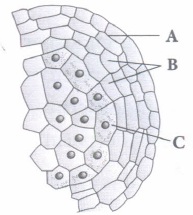
(a) A-Middle layer B-Endothecium C-Tapetum (b) A-Endothecium B-Tapetum C- Middle layer (c) A-Endothecium B-Middle layer C-Tapetum (d) A-Tapetum B-Middle layer C- Endothecium (iii) The function oflabelled part X is
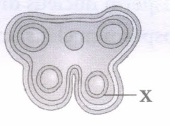
(a) dehiscence (b) mechanical (c) nutrition (d) protection (iv) Select the incorrect statement
(a) Microsporangium is generally surrounded by four wall layers-epidermis, endothecium, middle layers and tapetum
(b) Outer three layers perform functions of protection and dehiscence of anthers.
(c) Cells of tapetum possess dense cytoplasm and generally have more than one nucleus.
(d) Cells of tapetum undergo meiosis and produce microspore tetrads.
(v) Which function of tapetum is correct?
(a) Helps in pollen wall formation
(b) Transportation of nutrients to inner side of anther.
(c) Synthesis of callase enzyme for separation of microspore tetrads.
(d) All of these(a)
Case Study
*****************************************
Answers































